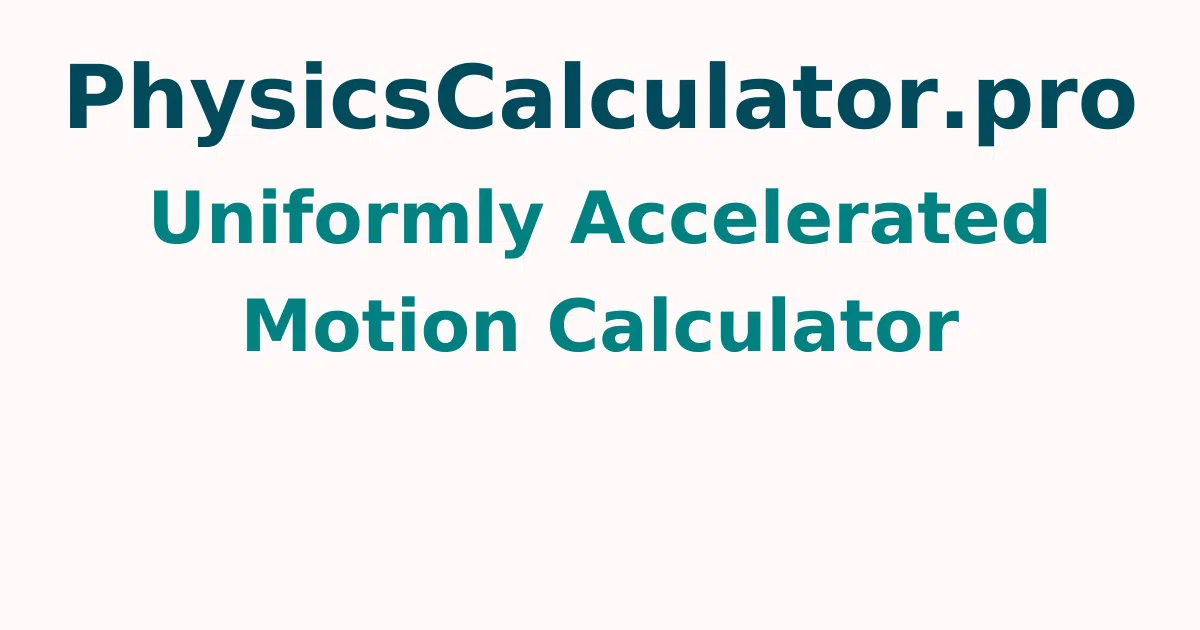Uniformly Accelerated Motion Calculator
We ensure that with this free Uniformly Accelerated Motion Calculator tool, you will be able to quickly determine an object's uniform acceleration. Simply enter the moving object's initial velocity, final velocity, and travelled distance in the provided input fields, then press the calculate button to get the outcome as acceleration and time right away.
What is Uniformly Accelerated Motion?
The motion of an object with a constant acceleration is known as uniformly accelerated motion (UAM). To put it another way, the acceleration remains constant; it is equivalent to a number that does not change as a function of time. Uniform acceleration refers to a body's constant acceleration depending on time.
Uniform Acceleration Motion Formulas
The following are the formulas for calculating uniform acceleration motion
- s = ½ (v + u) t
- v = u + at
- v² = u² + 2as
We can write the following formula, using the first formula t = (2s) / (v + u)
Acceleration is calculated using the third formula a = (v - u) / t where u = initial velocity, v = final velocity, a = acceleration of an object, t = time, s = distance travelled by an object.
Methods for determining Uniformly Accelerated Motion
The basic and simple steps listed below will assist you in answering uniform acceleration motion questions. Follow these instructions to ensure a successful outcome.
- Observe the object's initial velocity, final velocity, and distance travelled from the presented problem.
- Add the initial and final velocities after doubling the distance.
- To get the time value, multiply the double distance by the total of velocities.
- Subtract the object's ultimate velocity from its initial velocity and divide the result by time.
- The result is referred to as uniform acceleration.
How to Use the Uniform Acceleration Motion Calculator?
The following is the procedure how to use the Uniform Acceleration calculator
- Input the unknown's initial velocity, final velocity, distance travelled and x in the appropriate input fields.
- To acquire the result, click the "Calculate the unknown" button.
- Finally, in the output field, uniform acceleration of an object will be displayed.
For more concepts check out physicscalculatorpro.com to get quick answers by using this free tool.
How to Use the Uniform Acceleration Motion Calculator?<
- A person who has just jumped out of a plane.
- A bicycle on which the brakes have been deployed.
- A ladder's top rung dropped a ball.
- A toy baby bottle that escaped from the bathtub's bottom.
Examples on finding Uniform Acceleration Motion
Example 1:
From rest, a car accelerated at 7.5 m/s^2 for 10 seconds. a) What is the car's position at the end of the 10 seconds? b) What is the car's velocity at the end of the 10 seconds?
Solution:
The car starts from rest, the initial speed u = 0. We assume the initial position is equal to 0 because nothing is written about it. As a result, the equation gives the x position.
x = (1/2) a t2
where a is the acceleration (= 7.5 m/s^2) and t is the period of time between initial and final positions
x = (1/2) 7.5 (10)^2 = 375 m
b) The car's velocity ‘v’ at the end of 10 seconds is given by
v = a t = 7.5 x 10 = 75 m/s
FAQs on Uniformly Accelerated Motion Calculator
1. Is there a difference between constant and uniform acceleration?
Yes, they are identical. The terms constant acceleration and uniform acceleration refer to the fact that the rate of change of velocity with respect to time must be constant at all times.
2. Which correctly describes the case of a uniformly accelerated motion?
Non uniform motion describes the movement of an object that is speeding up or slowing down. Uniformly accelerated motion occurs when an object's speed increases at a constant rate.
3. What do you mean by uniform motion is uniformly accelerated motion?
The continuous acceleration of a body, regardless of the function of time, is referred to as uniform acceleration. A uniform accelerated motion on the horizontal plane or dimension occurs when an item moves at a constant velocity on the x-axis plane.
4. Is uniform acceleration zero?
A type of motion in which the velocity of an object changes by an identical amount every equal time period is known as uniform or constant acceleration. If the velocity does not change, the velocity is constant, and hence the acceleration is zero.
5. What is the uniform acceleration graph?
The displacement-time graph is a symmetric parabola about the displacement axis for homogeneous acceleration.
